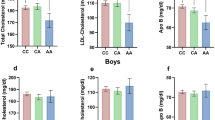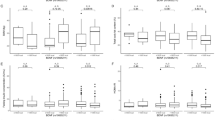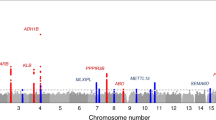Abstract
Despite the importance of total energy intake in circadian system regulation, no study has related human CLOCK gene polymorphisms and food-intake measures. The aim of this study was to analyze the associations of CLOCK single-nucleotide polymorphisms (SNPs) with food intake and to explore the specific role of the cytokine system. A total of 1100 individual participants in the Genetics of Lipid Lowering Drugs and Diet Network (GOLDN) study were included. Dietary intake was estimated with a validated questionnaire. Interleukin-6 (IL-6), monocyte chemotactic protein 1 (MCP1), tumor necrosis factor-α (TNF-α), IL-2 soluble receptor-α (IL-2sR-α) and adiponectin plasma concentrations were measured. Our results showed that four of five CLOCK SNPs selected were significantly associated with total energy intake (P<0.05). For SNP rs3749474, the energy intake and total fat, protein and carbohydrate intakes were significantly higher in minor allele carriers than in non-carriers. Frequency of the minor allele was greater in subjects with high energy intake than in those with low intake. Subjects with the minor allele were 1.33 times more likely to have high energy intake than non-carriers (95% CI 1.09–1.72, P=0.0350). All CLOCK SNPs were associated with plasma cytokine values, in particular with those that were highly correlated with energy intake: MCP1, IL-6 and adiponectin. Interestingly, minor allele carriers with high energy intake showed decreased cytokine values, which could be related with a lower anorectic effect and decreased sleep in these subjects. In conclusion, we show a novel association of genetic variation at CLOCK with total energy intake, which was particularly relevant for SNP rs3749474. Associations could be mediated through the alteration of cytokine levels that may influence energy intake and sleep pattern.
Similar content being viewed by others
Log in or create a free account to read this content
Gain free access to this article, as well as selected content from this journal and more on nature.com
or
References
Horne J : Short sleep is a questionable risk factor for obesity and related disorders, statistical versus clinical significance. Biol Psychol 2008; 77: 266–276.
Buijs RM, Kreier F : The metabolic syndrome, a brain disease? J Neuroendocrinol 2006; 18: 715–716.
Garaulet M, Madrid JA : Chronobiology, genetics and metabolic syndrome. Curr Opin Lipidol 2009; 20: 127–134.
Mendoza J, Pevet P, Challet E : High-fat feeding alters the clock synchronization to light. J Physiol 2008; 586 (Part 24): 5901–5910.
Monteleone P, Tortorella A, Docimo L et al: Investigation of 3111T/C polymorphism of the CLOCK gene in obese individuals with or without binge eating disorder, association with higher body mass index. Neurosci Lett 2008; 435: 30–33.
Guilding C, Piggins HD : Challenging the omnipotence of the suprachiasmatic timekeeper, are circadian oscillators present throughout the mammalian brain? Eur J Neurosci 2007; 25: 3195–3216.
Turek FW, Joshu C, Kohsaka A et al: Obesity and metabolic syndrome in circadian Clock mutant mice. Science 2005; 308: 1043–1045.
Vanitallie TB : Sleep and energy balance, Interactive homeostatic systems. Metabolism 2006; 55 (10 Suppl 2): S30–S35.
Vgontzas AN, Bixler EO, Lin HM, Prolo P, Trakada G, Chrousos GP : IL-6 and its circadian secretion in humans. Neuroimmunomodulat 2005; 12: 131–140.
Cintra DE, Ropelle ER, Pauli JR : Brain regulation of food intake and expenditure energy, molecular action of insulin, leptin and physical exercise. Rev Neurol 2007; 45: 672–682.
Iwase T, Kajimura N, Uchiyama M, Ebisawa T, Yoshimura K : Mutation screening of the human Clock gene in circadian rhythm sleep disorders. Psychiatry Res 2002; 109: 121–128.
Benedetti F, Radaelli D, Bernasconi A et al: Clock genes beyond the clock, CLOCK genotype biases neural correlates of moral valence decision in depressed patients. Brain Behav 2008; 7: 20–25.
Lamont EW, Legault-Coutu D, Cermakian N, Boivin DB : The role of circadian clock genes in mental disorders. Dialogues Clin Neurosci 2007; 9: 333–342.
Barnard AR, Nolan PM : When clocks go bad, neurobehavioural consequences of disrupted circadian timing. PLoS Genet 2008; 4: e1000040.
Scott EM, Carter AM, Grant PJ : Association between polymorphisms in the Clock gene, obesity and the metabolic syndrome in man. Int J Obes 2008; 32: 658–662.
Sookoian S, Gemma C, Gianotti TF, Burgueño A, Castaño G, Pirola CJ : Genetic variants of Clock transcription factor are associated with individual susceptibility to obesity. Am J Clin Nutr 2008; 87: 1606–1615.
Higgins M, Province M, Heiss G et al: NHLBI Family Heart Study, objectives and design. Am J Epidemiol 1996; 143: 1219–1228.
Thompson FE, Subar AF, Brown CC et al: Cognitive research enhances accuracy of food frequency questionnaire reports, results of an experimental validation study. J Am Diet Assoc 2002; 102: 212–225.
Subar AF, Thompson FE, Kipnis V et al: Comparative validation of the Block. Willett and National Cancer Institute food frequency questionnaires, the Eating at America's Table Study. Am J Epidemiol 2001; 154: 1089–1099.
Newby PK, Hu FB, Rimm EB et al: Reproducibility and validity of the diet quality index revised as assessed by use of a food-frequency questionnaire. Am J Clin Nutr 2003; 78: 941–949.
US Department of Agriculture: Food Guide Pyramid, a Guide to Daily Food Choices. Washington, DC: US Department of Agriculture. (Human Nutrition Information Service 1992; Home and Garden bulletin no. 232.
Tsai MY, Hanson NQ, Straka RJ et al: Effect of influenza vaccine on markers of inflammation and lipid profile. J Lab Clin Med 2005; 145: 323–327.
Bakker PIW, Yelensky R, Pe'er I, Gabriel SB, Daly MJ, Altshuler D : Efficiency and power in genetic association studies. Nat Genet 2005; 37: 1217–1223.
Marinescu VD, Kohane IS, Riva A : MAPPER: a search engine for the computational identification of putative transcription factor binding sites in multiple genomes. BMC Bioinformatics 2005; 6: 79.
Livak KJ : Allelic discrimination using fluorogenic probes and the 5′ nuclease assay. Genet Anal 1999; 14: 143–149.
Gruber AR, Lorenz R, Bernhart SH, Neuböck R, Hofacker IL : The Vienna RNA websuite. Nucleic Acids Res 2008; 36: W70–W74.
Lai CQ, Demissie S, Cupples LA et al: Influence of the APOA5 locus on plasma triglyceride, lipoprotein subclasses, and CVD risk in the Framingham Heart Study. J Lipid Res 2004; 45: 2096–2105.
Littell RC, Milliken GA, Stroup WW, Wolfinger RD : SAS System for Mixed Models. Cary, NC: SAS Institute, Inc., 1996.
Sheward WJ, Maywood ES, French KL et al: Entrainment to feeding but not to light: circadian phenotype of VPAC2 receptor-null mice. J Neurosci 2007; 27: 4351–4358.
Voight BF, Kudaravalli S, Wen X, Pritchard JK : A map of recent positive selection in the human genome. PLoS Biol 2006; 4: e72.
Ramsey KM, Marcheva B, Kohsaka A, Bass J : The clockwork of metabolism. Annu Rev Nutr 2007; 27: 219–240.
Whitelaw ML, Chapman-Smith A : The mammalian basic helix-loop-helix/PAS family of transcriptional regulators. Int J Biochem Cell Biol 2004; 36: 189–204.
Yang X, Downes M, Yu RT et al: Nuclear receptor expression links the circadian clock to metabolism. Cell 2006; 126: 801–810.
Sookoian S, Castaño G, Gemma C, Fernández-Gianotti T, Pirola CJ : Common genetic variations in CLOCK transcription factor are associated with nonalcoholic fatty liver disease. World J Gastroenterol 2007; 21: 4242–4248.
Cintra DE, Ropelle ER, Pauli JR : Brain regulation of food intake and expenditure energy: molecular action of insulin, leptin and physical exercise. Rev Neurol 2007; 45: 672–682. (in Spanish).
Cavadini G, Petrzilka S, Kohler P et al: TNF-alpha suppresses the expression of clock genes by interfering with E-box-mediated transcription. Proc Natl Acad Sci USA 2007; 104: 12843–12848.
Bagnasco M, Kalra PS, Kalra SP : Ghrelin and leptin pulse discharge in fed and fasted rats. Endocrinology 2002; 143: 726–729.
Obal Jr F, Krueger JM : Biochemical regulation of non-rapid-eye-movement sleep. Front Biosci 2003; 8: 520–550.
Taheri S, Lin L, Austin D, Young T, Mignot E : Short sleep duration is associated with reduced leptin, elevated ghrelin and increased body mass index. PLoS Med 2004; 1: e62.
Garaulet M, Madrid JA : Chronobiology, genetic and metabolic syndrome. Curr Opin Lipidol 2009; 20: 127–134.
Bastarrachea RA, López-Alvarenga JC, Bolado-García VE, Téllez-Mendoza J, Laviada-Molina H, Comuzzie AG : Macrophages, inflammation, adipose tissue, obesity and insulin resistance. Gac Med Mex 2007; 143: 505–512.
Pae CU : Monocyte chemoattractant protein-1 (MCP1) may play a role in depression. Biol Psychiatry 2008; 32: 313–314.
Viollet B, Mounier R, Leclerc J, Yazigi A, Foretz M : Targeting AMP-activated protein kinase as a novel therapeutic approach for the treatment of metabolic disorders. Diabetes Metab 2007; 33: 395–402.
Froy O : The relationship between nutrition and circadian rhythms in mammals. Front Neuroendocrinol 2007; 28: 61–71.
Hofstra WA, Weerd AW : How to assess circadian rhythm in humans: a review of literature. Epilepsy Behav 2008; 13: 438–444.
Boston RC, Moate PJ, Allison KC, Lundgren JD, Stunkard AJ : Modeling circadian rhythms of food intake by means of parametric deconvolution: results from studies of the night eating syndrome. Am J Clin Nutr 2008; 87: 1672–1677.
Rintamäki R, Grimaldi S, Englund A . et al: Seasonal changes in mood and behavior are linked to metabolic syndrome. PLoS ONE 2008; 3: e1482.
Acknowledgements
This work was supported by the Seneca Foundation from the Government of Murcia (project 02934/PI/05 to MG), the Government of Education, Science and Research of Murcia (Project BIO/FFA 07/01-0004) and by The Spanish Government of Science and Innovation (projects AGL2008-01655/ALI) and by Grants U01 HL72524 and HL-54776 from the National Institutes of Health, and DK075030 from the National Institute of Diabetes and Digestive and Kidney Diseases (NIDDK), and contracts 53-K06-5-10 and 58-1950-9-001 from the US Department of Agriculture Research Service. JMO.
Author information
Authors and Affiliations
Corresponding author
Additional information
Supplementary Information accompanies the paper on European Journal of Human Genetics website (http://www.nature.com/ejhg)
Supplementary information
Rights and permissions
About this article
Cite this article
Garaulet, M., Lee, YC., Shen, J. et al. Genetic variants in human CLOCK associate with total energy intake and cytokine sleep factors in overweight subjects (GOLDN population). Eur J Hum Genet 18, 364–369 (2010). https://doi.org/10.1038/ejhg.2009.176
Received:
Revised:
Accepted:
Published:
Issue date:
DOI: https://doi.org/10.1038/ejhg.2009.176
Keywords
This article is cited by
-
Potential protective effect against SARS-CoV-2 infection by APOE rs7412 polymorphism
Scientific Reports (2022)
-
Circadian CLOCK gene polymorphisms in relation to sleep patterns and obesity in African Americans: findings from the Jackson heart study
BMC Genetics (2017)
-
Association between genetic variants of the clock gene and obesity and sleep duration
Journal of Physiology and Biochemistry (2015)
-
Timing of food intake predicts weight loss effectiveness
International Journal of Obesity (2013)
-
Differences in circadian rhythmicity in CLOCK 3111T/C genetic variants in moderate obese women as assessed by thermometry, actimetry and body position
International Journal of Obesity (2013)



